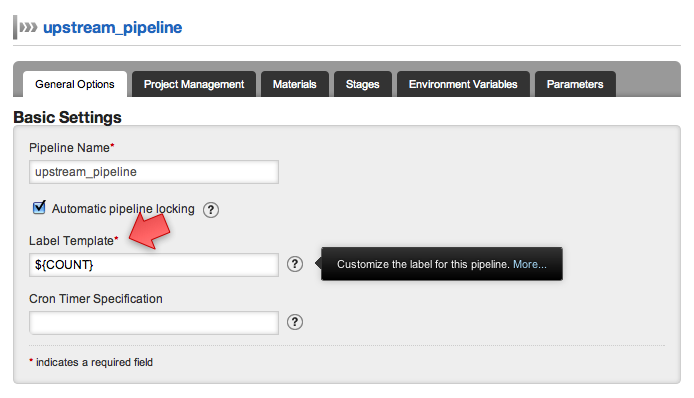- Home
- Download as PDF
- Contribute
- Introduction
- 1. Concepts In Go
- 2. Go Tour
- 3. Installing Go
-
4.
Configuration
- 4.1. Setup a New Pipeline
- 4.2. Managing Pipelines
- 4.3. Managing Dependencies
- 4.4. Managing Agents
- 4.5. Managing Environments
- 4.6. Pipeline Labelling
- 4.7. Pipeline Scheduling
- 4.8. Parameterize a Pipeline
- 4.9. Customize a Pipeline Label
- 4.10. Clone a Pipeline
- 4.11. Lock a Pipeline
- 4.12. Add Material to Existing Pipeline
- 4.13. Add Stage to Existing Pipeline
- 4.14. Add job to Existing Stage
- 4.15. Add task to Existing Job
- 4.16. Pipeline Templates
- 4.17. Choose When a Stage Runs
- 4.18. Timer Trigger
- 4.19. Job Timeout
- 4.20. Managing Users
- 4.21. Authentication
- 4.22. Authorizing Users
- 4.23. Delegating Group Administration
- 4.24. Pipeline Group Administration
- 4.25. Publish Reports and Artifacts
- 4.26. Managing Artifacts and Reports
- 4.27. Auto Delete Artifacts
- 4.28. UI Testing
- 4.29. Mailhost Information
- 4.30. Notifications
- 4.31. TFS Material configuration
- 4.32. Reference
- 4.33. Schema
-
5.
Advanced Usage
- 5.1. Auto Register a Remote Agent
- 5.2. Spawn multiple instances of a Job
- 5.3. Multiple Agents on One Machine
- 5.4. Clean on Task Cancel
- 5.5. Conditional Task Execution
- 5.6. Trigger With Options
- 5.7. Fan In
- 5.8. Properties
- 5.9. Compare Builds
- 5.10. Graphs
- 5.11. Command Repository
- 5.12. Backup Go Server
- 5.13. Other Config Options
- 6. Integrating Go With Other Tools
- 7. Go Api
- 8. Extension Points Of Go
-
9.
FAQ/Troubleshooting
- 9.1. Ordering of Pipelines
- 9.2. Historical Configuration
- 9.3. Concurrent Modifications to Config
- 9.4. Why the Build is Broken?
- 9.5. See artifacts as sub-tabs
- 9.6. Save Properties for a Build
- 9.7. Using Environment variables
- 9.8. Deploy to an environment
- 9.9. See changes in new binary
- 9.10. Run Tests against new Builds
- 9.11. Check What's Deployed
- 9.12. Deploy a Specific Build
- 9.13. Clone/Copy an Existing Agents
- 9.14. OAuth Overview
- 9.15. What is OAuth?
- 9.16. What is OpenSocial?
- 9.17. How do I re-run jobs?
- 9.18. Go unable to poll for changes
- 9.19. Artifact integrity verification
- 9.20. Email Notifications
- 9.21. Running out of Disk Space
- 10. Beta features
- 11. Release History
- Published using GitBook
Pipeline Labelling
Go maintains an internal counter to identify a pipeline. This number increases by 1 for each build. By default, Go will use this counter as the pipeline label. This label is also passed to your build as an environment variable: GO_PIPELINE_COUNTER . The pipeline counter increases even if a build fails.
The concept of pipeline counters was introduced in release 1.3.2. In order to maintain backward compatibility with historical data Go now uses negative values as counter for pipelines created by older releases of Go. Hence it is perfectly normal for a historical pipeline to have a negative counter with positive label.
Customising the pipeline label
You can create a custom label by setting the Label Template field on your pipeline. This will change the value that Go shows on its webpages. It will also change the value of the GO_PIPELINE_LABEL property that is passed to your build. You can refer to ${COUNT} or material names which are defined in the configuration of materials.

Power users can still edit the config xml to achieve the same. The xml snippet to configure labelTempalte is below.
<pipeline name="my-pipeline" labeltemplate="1.2.${COUNT}">
...
</pipeline>
Using a pipeline in the labeltemplate:
<pipeline name="my-dependent-pipeline" labeltemplate="${MY_PIPELINE}">
<materials>
<pipeline pipelineName="my-pipeline" stageName="my-stage"/>
</materials>
...
</pipeline>
Using a VCS material in the labeltemplate. In this example, the Subversion revision number will be used as the labeltemplate:
<pipeline name="my-material-pipeline" labeltemplate="1.2.${SVN_MATERIAL}">
<materials>
<svn url="http://svn.example.com/" dest="svn" materialName="SVN_MATERIAL" />
</materials>
...
</pipeline>